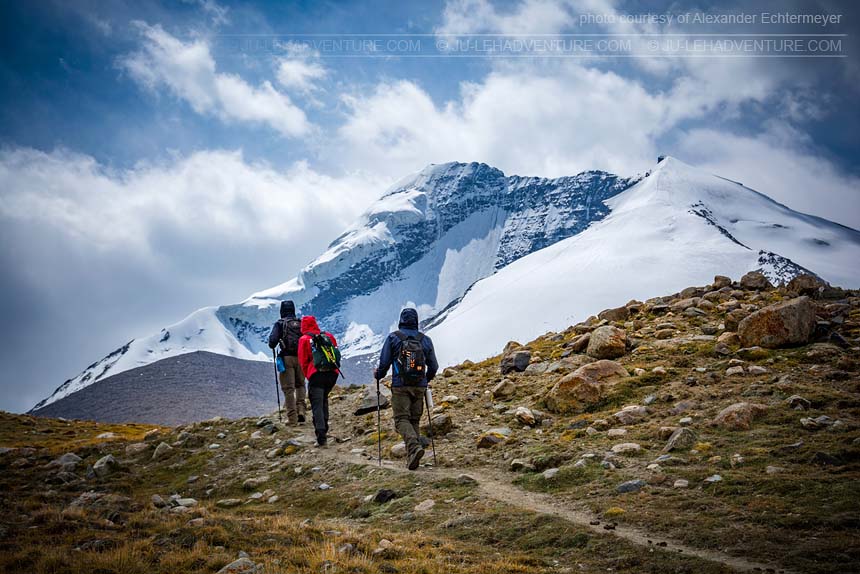Markha valley trek from Chilling
Duration: 6 days
Difficulty: level 3
Distance: 78 km
Max elevation: 5260m
Elevation gain / loss: +2502m / -2019m
The Markha valley trek is one of the most popular treks in Ladakh. This trek passes through beautiful villages tucked in the deep valley surrounded by towering mountains. The high pass of Kongmaru La offers spectacular views of the Kang Yatse peaks. You can stay in homestays throughout the trek and it’s an excellent opportunity to discover the everyday life of locals. Markha is part of the Hemis National Park, home to the elusive snow leopard. This trek from Chilling is a shorter and easier version of the Markha valley trek from Spituk.
If you would like to join a group, check our Fixed Departure Treks.
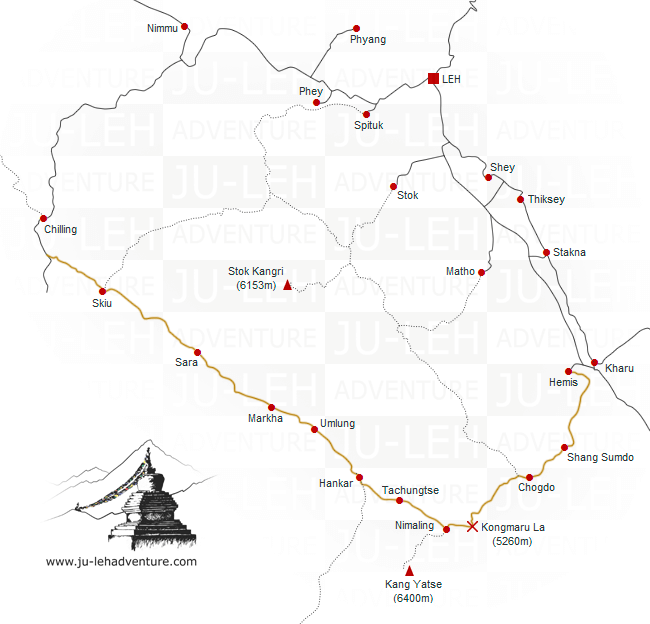
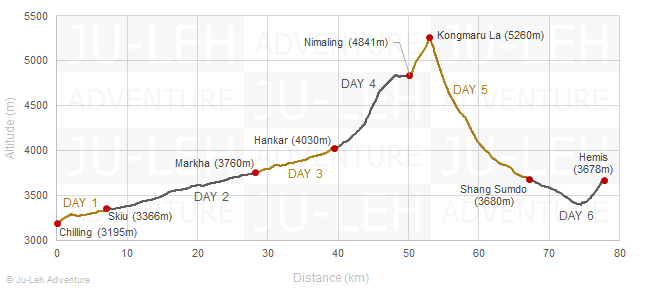
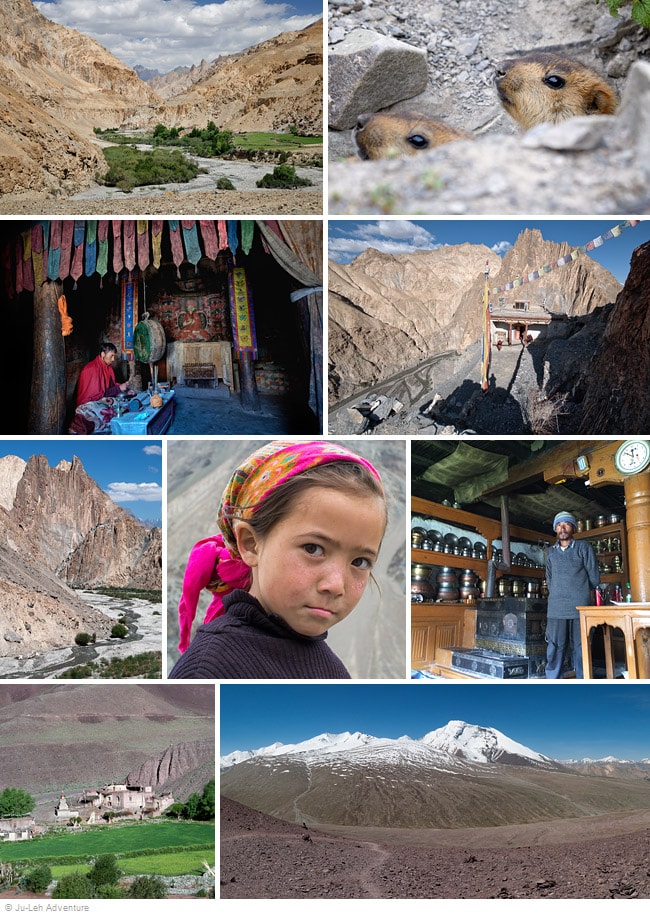
Itinerary
Day 1: Chilling - Skiu
Time: 2-3 hrs
Distance: 6.9 km
Elevation gain / loss: +189m / -18m
| - | cross the Zanskar river and enter the Hemis National Park |
| - | follow the trail to Markha valley |
| - | homestay can be arranged in Skiu |

Day 2: Skiu - Markha
Time: 6-7 hrs
Distance: 21.2 km
Elevation gain / loss: +451m / -57m
| - | continue walking along the river, the trail to Markha passes through small villages |
| - | Markha is a pretty village with just around 20 households |
| - | you can visit the old monastery and the ruined fort which are above the village |
| - | homestay is available in Markha |

Day 3: Markha - Hankar
Time: 4-5 hrs
Distance: 11.2 km
Elevation gain / loss: +305m / -35m
| - | walk along the river |
| - | you can visit Techa gompa which is built on a cliff near Umlung village |
| - | homestay is available in Hankar |

Day 4: Hankar - Nimaling
Time: 5-6 hrs
Distance: 10.7 km
Elevation gain / loss: +836m / -25m
| - | the path starting from Hankar village leads you to Nimaling, where villagers bring their cattle for grazing during summer |
| - | there is a possibility for enthusiastic trekkers to hike to the base of the Kang Yatse glacier in a few hours from Nimaling |

Day 5: Nimaling - Kongmaru La - Shang Sumdo
Time: 6-8 hrs
Distance: 17.0 km
Elevation gain / loss: +439m / -1601m
| - | ascend the Kongmaru La and enjoy the spectacular views of Kang Yatse and Karakoram peaks from the pass |
| - | the descent is steep and long towards the Shang gorge |
| - | you need to cross the river several times before you reach the village |
| - | homestay can be arranged in Shang Sumdo |

Day 6: Shang Sumdo - Hemis
Time: 3-4 hrs
Distance: 10.7 km
Elevation gain / loss: +281m / -283m
| - | walk to Hemis monastery, one of the well-known monasteries in Ladakh |
| - | jeep can be arranged from Shang Sumdo or Martselang to Hemis |

Getting to / from the trek
| - | it takes one hour and a half to drive from Leh to Chilling (60 km) |
| - | it takes one hour to drive from Hemis to Leh (40 km) |
It is worth taking some extra time to stop and visit the highlights in the area, check the Indus valley tour to Hemis for more details.
All the itineraries can be customized to suit your own special interests, preferences and abilities. Please contact us for more information.
Markha valley trek - FAQ
How long is the Markha valley trek?
The Markha valley trek is often done in 6 days, from Chilling to Hemis. This trek itinerary covers a distance of 78 km and 2500m of elevation gain. It crosses one high-altitude pass. The duration of 6 days is the total duration from Leh to Leh, including transport to the start point and from the end point of the trek.
How high will I go on the Markha valley trek?
The highest point on the Markha valley trek is the Kongmaru La pass at an altitude of 5260m. The pass is usually crossed on the 5th day, while trekking from Nimaling to Shang Sumdo. The highest night is spent at Nimaling camp, at an elevation of 4841m. This is generally the 4th night of the trek, i.e. the night before crossing the Kongmaru La pass.
How difficult is the Markha valley trek?
The Markha valley trek, as compared to other treks in Ladakh, is considered as moderate in difficulty (level 3 out 5). You need to be in good physical condition. Previous trekking experience is desirable, but not essential if you are confident of your physical condition.
Is the Markha valley trek crowded?
The Markha valley trek is the most famous trek in Ladakh because it is one of the most beautiful treks. However, even during the peak tourist season (July-August), the Markha valley trek is not really busy and tourists can enjoy the nature without being disturbed by other groups. Indeed, the Markha valley trek is far less crowded than the famous treks in Nepal (Annapurna, Everest Base Camp…).
How many days of acclimatization are needed before starting the Markha valley trek?
Leh is at 3500m above sea level so acclimatization can get difficult because of high altitude. You shall spend at least 3 days to acclimatize before you start the Markha valley trek and go to higher altitude. Drink plenty of water or other fluids such as soup, tea and juice. During acclimatization, you can visit Leh and the Indus valley.
What will the weather be like during the Markha valley trek?
The weather in Ladakh is generally dry and sunny. During the summer, the average temperature goes up to 25 or 30 degrees Celsius in the day while the nights are cooler depending on the altitude (it can reach the freezing point at Nimaling in September). However, the weather in the mountain can change quickly and outbreaks of rain can occur; you should be prepared for this possibility. The sun is strong in Ladakh and some days can be really hot during the Markha valley trek, especially in the valleys at lower altitude.
Ladakh is a high-altitude desert and portion of Tibetan plateau extends in the northern plains of the Changthang region. The high mountains stop the rain clouds so Ladakh is not affected by the monsoon. However, some light to moderate showers can be experienced occasionally. All mountains trekkings and activities are planned according to the good weather but one should remember that in any mountain area weather is not predictable and you should be prepared and fully equipped to deal with weather.
How are the homestays during the Markha valley trek?
During the Markha valley trek, every night will be in a local house in a village (homestay) except the night in Nimaling which will be in a fixed camp.
We encourage our clients to stay in homestays during their trek. This is an effort to stem the region's rural-urban migration and generate income to the rural communities in Ladakh. Since all the households have their own homestay and they take turns in hosting guests, it ensures that money is equally distributed between the families. The homestay system does not allow for advanced booking. In some cases, a large group might be divided in two separate houses.
Comfort in homestays is basic, but it is a nice opportunity to discover the everyday life of the villagers. Homestays do not have running water so it is not possible to take shower. You should bring your own sleeping bag during the trek. If you feel cold, blankets are available in homestays and at Nimaling camp but they can be quite dusty. At Nimaling, tents and mattresses will be provided too.
What will I eat during the Markha valley trek?
The family at the homestay will give you typical vegetarian Ladakhi food such as rice, dal (lentils), vegetables, soup, momos (dumplings), chutagi (homemade pasta mixed with vegetables), thukpa (noodle soup) ... Every morning, the family will prepare a packed lunch for you (chapati, potatoes, boiled egg... it depends on the homestay). Note that in general the food is simple and there is not much variety, this is what the villagers eat every day.
Where will I get drinking water during the Markha valley trek?
During the trek, boiled or filtered water will be provided to fill up your water bottles. For extra safety, we recommend that you use water purification tablets.
Will I be able to charge my camera/phone batteries during the Markha valley trek?
Homestays usually have solar panels so it is possible to charge batteries during the Markha valley trek. You should also bring spare batteries. Note that batteries discharge more quickly in cold weather.
Will my mobile phone work during the Markha valley trek?
Only mobile phones with a local sim card work in Ladakh. In the Markha valley, there is limited mobile phone network coverage. Each village has a satellite phone which can be used in case of emergency. Note that personal satellite phones are forbidden in Ladakh.
What do I need to carry for the Markha valley trek?
During the trek, you should keep a light backpack with you during the day with a water bottle, your packed lunch, hat, sunglasses, sun cream, camera, etc.
Will I have a porter during the Markha valley trek?
In Ladakh, horses are used to carry luggage. Unlike in Nepal, using the services of a porter during treks is not common in Ladakh.
During the Markha valley trek, your duffel bag / backpack containing your sleeping bag and the clothes which you don’t need during the day will be carried by horses. The weight and size of this bag should be reasonable. Note that hard suitcases are not suitable because they cannot be taken on horseback. Other luggage that you do not need during the trek should be kept in Leh. Hotels and guesthouses in Leh usually have a storage room.
How to extend the Markha valley trek?
A very popular option is to start the Markha valley trek from Spituk, instead of from Chilling. In that case, 2 extra days are needed to complete the itinerary. At the end of the trek, it is a good idea to take some time to visit the well-known monasteries located in the Indus valley between Hemis and Leh.
What is the group size for the Markha valley trek?
If you join a group trek for the Markha valley, the group size will be between 4 and 9 persons. If you book a private trek, you can decide about the group size as well as the trekking dates.
How do I get from Leh to the Markha valley trek?
The transport from Leh to Chilling (at the beginning of the Markha valley trek) and from Hemis to Leh (at the end of the trek) will be arranged by car. The distance between Leh and Chilling is 60 km. The distance between Hemis and Leh is 40 km.

 Hemis to Tso Moriri
Hemis to Tso Moriri

